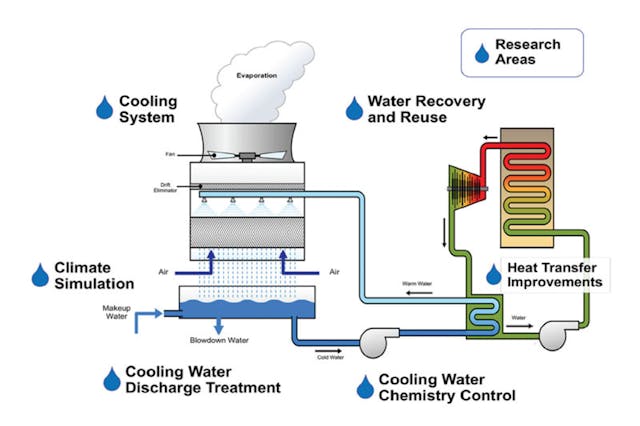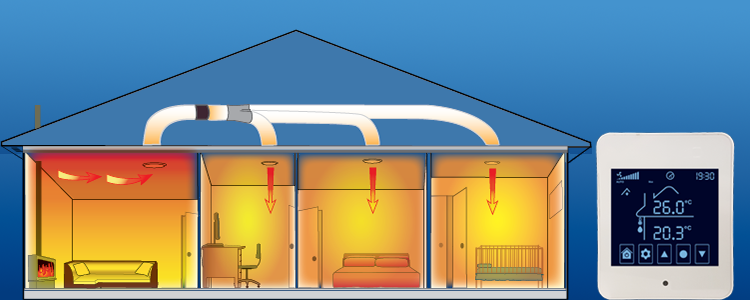Checking out the Conveniences and Applications of Heat Transfer Systems in Modern Industry
Heat transfer systems play a vital function in contemporary industry. They incorporate different systems such as convection, radiation, and conduction, each adding to effective thermal management. Industries like manufacturing and aerospace advantage substantially from these systems. As improvements continue, the integration of cutting-edge products and technologies promises to boost energy efficiency. This advancement increases essential concerns concerning the future implications for sustainability and functional prices across several markets. What lies ahead in this recurring improvement?
Recognizing Heat Transfer Principles
Heat transfer principles are fundamental to the procedure of various commercial systems. These principles incorporate the mechanisms of radiation, conduction, and convection, each playing an essential function in handling thermal power. Understanding transmission involves evaluating just how Heat relocates via solid products, while convection pertains to Heat transfer in liquids, driven by fluid activity. Radiation, distinct from the other two, includes power transfer through electro-magnetic waves. The efficiency of Heat transfer impacts system performance, power intake, and overall efficiency. Reliable thermal monitoring is necessary in procedures such as air conditioning, Heat, and home heating recuperation. By understanding these principles, industries can enhance their procedures, minimize power costs, and improve devices long life, therefore contributing to a more sustainable and effective commercial landscape.
Trick Kinds Of Heat Transfer Systems
While various markets make use of Heat transfer systems for varied applications, several key types stand out because of their particular functions and performances. One of the most usual kinds consist of conduction, convection, and radiation systems. Conduction systems transfer Heat through direct contact in between products, making them reliable in solid-state applications. Convection systems, on the various other hand, utilize fluid activity to move Heat, appropriate for heating or cooling fluids and gases. Radiation systems run without a tool, depending on electromagnetic waves to transfer Heat, ideal for high-temperature environments. Each kind offers unique functions, allowing industries to customize their Heat transfer solutions based upon functional needs, energy effectiveness, and cost-effectiveness. Comprehending these systems is vital for maximizing performance in various commercial settings.
Industrial Applications of Heat Transfer Technologies
The application of Heat transfer technologies in sector plays an essential duty in boosting energy efficiency and enhancing processes. DVS Heat Transfer Systems. By applying sophisticated Heat exchange systems, companies can greatly lower their environmental influence while enhancing total efficiency. This integration not just fosters sustainability yet likewise straightens with contemporary governing and consumer needs for greener practices
Power Efficiency Improvements
As sectors progressively focus on sustainability, energy effectiveness improvements in Heat transfer technologies have actually come to be crucial for minimizing functional costs and ecological influence. Improved Heat exchangers, for circumstances, make use of advanced products and layouts to take full advantage of thermal efficiency while minimizing energy usage. Incorporating variable rate drives in pumping systems enables for far better control of liquid circulation, leading to significant power savings. The application of clever sensing units and automation offers real-time surveillance, making it possible for modifications that enhance power usage. In addition, waste Heat recovery systems record excess thermal power, converting it into usable power. These improvements not only enhance energy effectiveness however additionally contribute to a more lasting industrial landscape by lowering greenhouse gas emissions and supporting conformity with ecological regulations.
Refine Optimization Techniques
Refine optimization strategies are critical in boosting the performance and performance of Heat transfer modern technologies in commercial applications. These methods involve refining procedures to optimize Heat transfer performance while minimizing power intake and functional expenses. Methods such as computational liquid characteristics (CFD) modeling permit designers to imitate and examine Heat transfer circumstances, recognizing locations for renovation. In addition, real-time tracking systems can offer valuable information on temperature level gradients and circulation rates, making it possible for changes that enhance performance. Applying advanced control techniques, such as anticipating analytics, can boost system responsiveness to differing functional needs. By applying these optimization techniques, sectors can accomplish higher thermal performance, minimized downtime, and enhanced product high quality, ultimately causing enhanced competition in the marketplace.

Ecological Influence Reduction
While commercial Heat transfer This Site innovations are important for functional efficiency, their application additionally offers opportunities for substantial environmental impact decrease. By boosting energy effectiveness, these systems minimize fuel usage, leading to lower greenhouse gas exhausts. Progressed Heat exchangers can recuperate waste Heat, redirecting it to preheat inbound fluids, therefore reducing energy demands. Furthermore, the assimilation of Heat transfer technologies in sustainable energy systems, such as solar thermal and geothermal applications, sustains the change to lasting methods. Industries that use these technologies also gain from minimized functional expenses and boosted governing compliance. In general, the calculated execution of Heat transfer systems not just strengthens performance yet additionally cultivates an extra lasting commercial landscape, adding to international ecological objectives.
Benefits of Effective Heat Transfer Systems
Effective Heat transfer systems provide considerable advantages in modern industry, primarily via boosted power performance and expense reduction. By enhancing thermal management, these systems minimize power waste, bring about reduced operational expenses (DVS Heat Transfer Systems). Organizations can achieve higher sustainability and improved profitability.

Energy Efficiency Improvements
As markets significantly focus on sustainability and cost-effectiveness, energy efficiency improvements in Heat transfer systems have become an essential emphasis. Boosted efficiency in these systems causes minimized energy intake, allowing facilities to run more sustainably. By enhancing Heat transfer methods, sectors can minimize waste Heat and achieve better thermal management, significantly reducing their environmental effect. Breakthroughs in modern technologies such as Heat exchangers and insulation products add to enhanced performance and reliability. Additionally, executing energy-efficient Heat transfer options not only supports compliance with regulatory criteria yet likewise fosters a culture of development within organizations. Eventually, these improvements are important in aligning commercial operations with global power preservation goals, leading the Read Full Article method for a more lasting future in manufacturing and handling industries.
Cost Decrease Opportunities
By optimizing Heat transfer systems, markets can disclose considerable cost reduction opportunities that boost their profits. Effective Heat transfer minimizes energy usage, leading to reduced utility expenses and minimizing functional costs. Additionally, improved system efficiency lowers the requirement for upkeep and repair work, in addition saving costs with time. Boosted Heat transfer can likewise prolong tools life-span, permitting companies to postpone capital expenditures on substitutes. Waste Heat recovery systems can transform excess Heat into functional energy, further driving down prices. These systems not just simplify procedures yet also contribute to sustainability campaigns, positioning business positively in a progressively eco-conscious market. Overall, the financial benefits of effective Heat transfer systems are crucial and substantial for competitive advantage.
Advancements in Heat Transfer Solutions
Just how can modern-day sector improve its procedures with ingenious Heat transfer remedies? By adopting advanced products and technologies, sectors can substantially boost thermal performance and performance. Developments such as nanofluids, which improve Heat transfer capabilities beyond traditional fluids, and phase change materials that store and launch thermal power, are obtaining grip. In addition, the assimilation of wise sensors and IoT tools permits real-time tracking and optimization of Heat transfer procedures, decreasing waste and boosting system responsiveness. In addition, additive production methods allow the production of more complex Heat exchangers that make the most of surface while minimizing product use. Jointly, these technologies drive functional effectiveness and create affordable advantages in numerous markets, including production, energy, and aerospace.
The Role of Heat Transfer in Sustainability Initiatives
While the push for sustainability proceeds to reshape markets, the function of Heat transfer innovations becomes increasingly necessary in accomplishing environmental goals. Reliable Heat transfer systems facilitate energy performance by enhancing thermal monitoring in various procedures, considerably lowering energy usage and greenhouse gas exhausts. For example, progressed Heat exchangers are utilized in commercial applications to redeem waste Heat, consequently lessening energy waste. Additionally, innovations such as phase change materials improve thermal storage space, adding to renewable resource combination. The adoption of sustainable liquids in Heat transfer systems can lower environmental effect. By focusing on reliable Heat transfer, sectors not just boost operational performance but likewise line up with worldwide sustainability efforts, promoting a cleaner, a lot more lasting future.
Regularly Asked Inquiries
Just How Do Heat Transfer Equipments Influence Power Prices in Production?
Heat transfer systems considerably influence energy costs in manufacturing by enhancing efficiency, decreasing waste, and optimizing thermal management. These improvements result in lower functional expenditures, inevitably profiting general productivity and success in industrial procedures.
What Upkeep Is Required for Heat Transfer Systems?
Upkeep for Heat transfer systems consists of routine evaluations, cleaning of parts, examining fluid levels and problems, replacing worn components, and ensuring correct insulation. These actions enhance performance, prolong life expectancy, and prevent pricey malfunctions in operation.
Are There Safety Concerns With Heat Transfer Systems?
Security interest in Heat transfer systems consist of prospective leakages, stress build-up, and thermal threats. Proper layout, regular maintenance, and adherence to safety and security protocols are vital to minimize these risks and ensure secure operation in industrial settings.
How Can I Select the Right Heat Transfer System for My Business?
Picking the ideal Heat transfer system involves reviewing factors such as efficiency, application requirements, budget constraints, and safety standards. A comprehensive analysis of these components will certainly help guarantee perfect efficiency and reliability in service procedures.
What Are Typical Failings in Heat Transfer Solutions and Their Causes?

Comprehending transmission involves examining how Heat relocates via solid materials, while convection pertains to Heat transfer in fluids, driven by fluid activity. By optimizing Heat transfer approaches, industries can lessen waste Heat and accomplish far better thermal management, considerably lowering their ecological influence. Waste Heat recovery systems can transform excess Heat right into useful power, further driving down expenses. Advanced Heat exchangers are utilized in commercial applications to see this site reclaim waste Heat, thus lessening power waste. Usual failings in Heat transfer systems consist of leakages, deterioration, and inefficient Heat exchange.